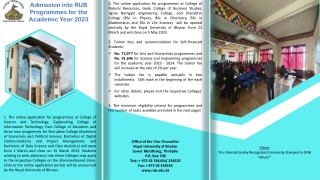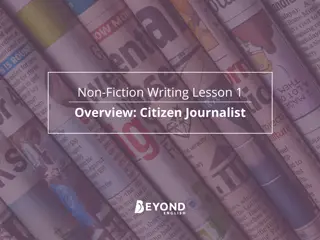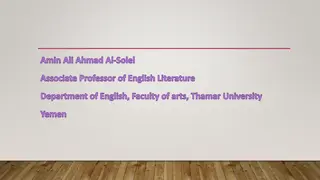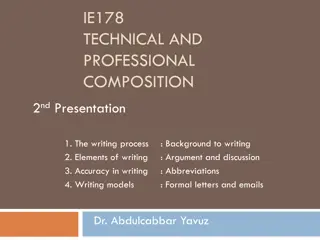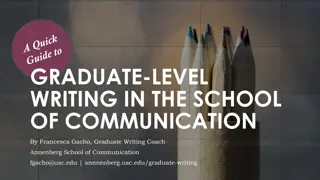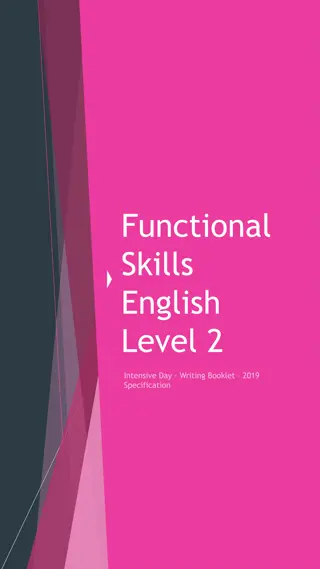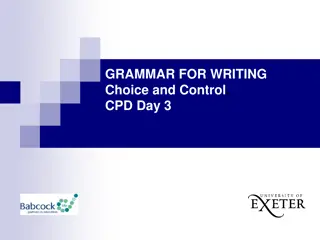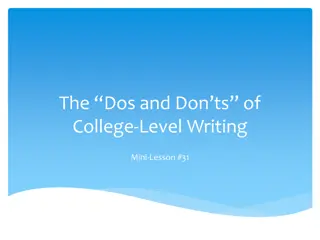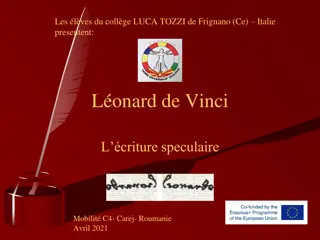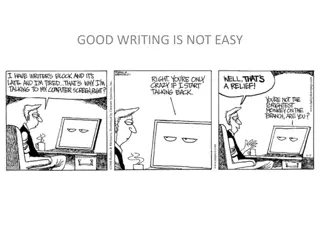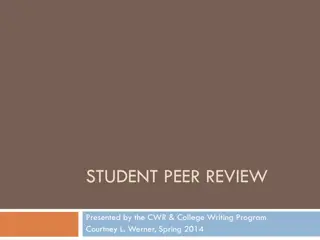
Effective Writing Tips and Quotes for Writers
Explore a collection of insightful quotes and tips for writers on the art of effective writing. Learn valuable advice from renowned authors and experts like Toni Morrison, Mark Twain, and more. Discover the importance of expressing over impressing, separating writing and revising, and proofreading diligently. Enhance your writing skills with wisdom shared by writing professionals.
Uploaded on | 1 Views
Download Presentation

Please find below an Image/Link to download the presentation.
The content on the website is provided AS IS for your information and personal use only. It may not be sold, licensed, or shared on other websites without obtaining consent from the author. If you encounter any issues during the download, it is possible that the publisher has removed the file from their server.
You are allowed to download the files provided on this website for personal or commercial use, subject to the condition that they are used lawfully. All files are the property of their respective owners.
The content on the website is provided AS IS for your information and personal use only. It may not be sold, licensed, or shared on other websites without obtaining consent from the author.
E N D
Presentation Transcript
THINK WRITE! BY Mamie Webb Hixon UWF Writing Lab Director October 2014
THINK WRITE Toni Morrison said, Everybody writes badly sometime.
THINK WRITE Write when you write Revise when you revise Never mix the two
THINK WRITE Write to express, not to impress.
THINK WRITE Write responsibly proofread and edit your written work before printing, publishing, submitting, or sending it.
THINK WRITE Mark Twain said, The essay is something that everybody wants to have read but nobody wants to write.
THINK WRITE Donald H. Ross said, Don t expect your reader to accept a piece of writing you wouldn t accept yourself.
THINK WRITE What is written without effort is in general read without pleasure. - Samuel Johnson
THINK WRITE Those who write well have readers; those who write poorly have critics and commentators.
THINK WRITE Mamie Webb Hixon said, Write in such a way that the reader will judge you by the content of your paper, not by the conjugations of your verbs. Avoid expressions such as had went, had did, and had came.
THINK WRITE Frank Smith said, Poor writers are more likely to be satisfied with what they ve written without really knowing what they ve written.
The Cs of College-Level Writing
C-writing C-writing suggests competence. It reveals some degree of unity and focus, but neither is fully realized nor effectively achieved. The writing may be padded and repetitious; it may even be a series of truisms with little indication of the writer's intellectual involvement with the subject. C-writing shows an awareness of organization, but overall, the writing is thin. Even though there is a workable essay format, international support is shallow; there are numerous generalizations without support. Sometimes, a paragraph will go nowhere, and the writer will move from one paragraph to another without transition. The writing will often seem directionless. Because there is a tendency for C-writing to depend largely on the cliche, there are frequent lapses into inappropriate slang, jargon, and colloquialisms. Vocabulary reveals lack of range; therefore, paper has a minimal but workable vocabulary keeping the writing fairly undistinguished until the writer has more verbal resources to work with. Grammar and mechanics are handled with some degree of accuracy. Errors suggest uncertainty and a need for improvement. Finally, C-writing has errors which even a cursory proofreading would have eliminated.
B-writing B-writing demonstrates competence. It also shows a clear sense of order, although the author may not be totally successful in consistently and appropriately presenting topic sentences and concrete supporting details. Frequently, one point will be fully developed and two or three others will be skimpily treated. Nonetheless, all ideas are focused and unified and tailored to relate to the central point. B-writing shows evidence of effective use of transitions, for the most part. It also reveals a rather clear control of grammar and mechanics; there may be only a few errors, but they are not serious enough to diminish the overall quality of the writing. The writer generally uses a judicious choice of words. Paper shows evidence of some proofreading.
A-writing A-writing demonstrates unusual competence. It shows that the author has something to say, or, if the topic is rather barren, the writer finds a way of making something of nothing, for instance, presenting the information in such a way that the reader sees it anew. It is clearly, if not distinctively, written. A-papers also have individuality and aptness of diction. Syntactically, they are smooth, often elegant, even when the writing includes rather involved sentences. Ideas are developed flexibly, clearly, and fluently in sufficient depth and breadth. A- writing reveals the writer's ability to formulate ideas and synthesize information, thus revealing the scope or latitude of his knowledge. Further, it uses an intelligent and literate vocabulary. Finally, it demonstrates mastery of mechanics and grammar, and an ability to punctuate rhetorically, using punctuation for effect and clarity. There are, overall, few, if any, errors and absolutely no interferences to thought. Paper shows evidence of careful planning, writing, and editing.
The Cs of WRITING A good paper should be Comprehensive The paper has supporting and fully explained evidence taken from the text or other reliable sources, with all evidence in correct citation style and with the writer illustrating full understanding of the topic.
The Cs of WRITING A good paper should be Clear The paper uses plain, direct, understandable language and sentence construction to make its purpose obvious, and it is void of logical flaws, obscurities, ambiguities, and other statements that might derail your reader.
The Cs of WRITING A good paper should be Credible The paper contains accurate and verifiable information presented in an academic tone and voice, and it reflects a high level of professionalism.
The Cs of WRITING A good paper should be Correct The paper uses language effectively, appropriately, and correctly; the language also conforms to the rules of standard written American English grammar, punctuation, sentence construction, spelling, capitalization, and diction and adheres to the conventions of its particular format.
Dont expect your reader to accept a piece of writing you wouldn t accept yourself. - Donald H. Ross PROOFREAD your paper. Turn on all SPELLING, GRAMMAR, and STYLE CHECKS. Make sure your paper is neat and WELL-PRESENTED.
The Cs of WRITING A good paper should be Coherent The paper is well organized and easy to read. Its supporting paragraphs and textual support address the thesis or main idea. The paper utilizes fluid transitions to move from point to point, but it does not deviate from the overall topic or theme.
The Cs of WRITING A good paper should be Cohesive The paper presents information in a manner that is logically connected and consistent so that the reader may readily follow the progression of the writer's argument. Its use of smooth transitions makes it fluid, moving logically from one idea to the next.
The Cs of WRITING A good paper should be Concise The paper is free of redundant and meaningless words in order to make each sentence as clear and expressive as possible.
The Cs of WRITING A good paper should be Concentrated The paper maintains a direction of attention toward the argument at hand, focusing only on ideas or information that develops the topic.
The Cs of WRITING A good paper should be Conversant The paper reveals that you are familiar with the subject from either experience or research. It engages the topic and adds to the academic discourse on that topic. Though conversant, the paper does not contain conversational language or tone.
The Cs of WRITING A good paper should be Critical The paper is not a summary, but an evaluative critique whose claims are analytical and argumentative.
The Cs of WRITING A good paper should be Controversial The paper presents a defined, debatable argument and provides accurate and relevant information regarding the topic.
The Cs of WRITING A good paper should be Complex The paper addresses the prompt in a thorough, interesting, and unique manner while taking into account all the intricacies of the question and all the possible arguments and counterarguments applicable to the exploration of the question.
The Cs of WRITING A good paper should be Contextual The paper sums up your informed opinion about the subject or presents carefully synthesized facts and data about the subject.
The Cs of WRITING A good paper should be Clever The paper uses language and style that will be particularly pleasing to the reader, and it also anticipates and addresses questions that the reader may or may not have considered about the content of the paper. A clever paper strives to be witty, sharp, inventive, resourceful, intelligent, and astute.
The Cs of WRITING A good paper should be Convincing The paper demonstrates mastery in the use of reliable supporting data, relevant quotations, and appropriate and varied introductory verbs for quotations. It uses language that appeals to reason and maintains a calm, objective demeanor in order to persuade the reader of the validity of its primary claim.
The Cs of WRITING A good paper should be Compelling The paper s engaging use of language, clear development of argument, precise word choice, and logical organization compel the reader to consider a new way of thinking about the world.
The Cs of WRITING A good paper should be Creative The paper presents the details in an unusual and creative way to make the reader see the subject anew.
The Dos and Donts of College-Level Writing Mini-Lesson #31
The Ds of Writing Don t make your writing instructor the first person to read your paper. You and someone else should read and proofread it first. Don t be the only person who didn t read your paper. You wrote it. Proofread and edit it too. Don t shift into rant mode, that is, being excessively repetitive, antagonistic, and subjective about a subject that has several sides. Make your paper reader friendly.
The Ds of Writing Don t use tags such as I think, I believe, and in my opinion, since it is assumed that the thoughts expressed in the paper (other than those cited as resources) belong to you. Don t use conversational English such as slang or colloquialisms except to achieve a particular tome or rhetorical effect. Don't shift from past to present tense or present to past unnecessarily.
The Ds of Writing Don't use clich s such as last but not least, arguably, and as a whole; find exact words. As writer James Orwell quipped, Don t use a word or phrase you re used to seeing in print. Don t write in passive voice when you need to make a specific statement about the performer of the action. Don t use redundant phrases such as each and every, continue on, and due to the fact that.
The Ds of Writing Don t use second-person pronouns (you and your) unless you are writing a business correspondence. Don t use contractions or abbreviations. Don't use sexist language such as fireman, policeman, postman or masculine pronouns (he, him, his) to refer to a generic group.
What about the 5-Paragraph Essay? The 5-paragraph model does not cut it for college-level writing. Very limiting Encourages bad habits
A College Essay Should Have An introduction that contains a thesis statement A body A conclusion
Introduction Should provide only essential background information Can be more than one paragraph Needs to contain a thesis statement/argument/ the point of your paper
Thesis Statements A thesis statement is the main argument of your paper. It should not be too broad or too narrow. A thesis statement is NOT simply a theme or trope (i.e., love, money, happiness). Stating that an author discusses love is not an adequate thesis; instead, a thesis should be something someone could argue.
Body Paragraphs The purpose of the body paragraphs, and really your entire paper, is to support the argument your thesis makes. Include critical sources and textual evidence (if applicable) to strengthen your argument. The progression of the paper and your argument should be logical and easy to follow.
Conclusion The conclusion should review or restate the main points of the essay; however, this should NOT be an exact repetition. A conclusion needs to answer the question So what?
Getting Started Brainstorm. Write down ideas you have, even if you don t think they will make it into your paper. Construct an outline. Talk to your professor. Come to the Writing Lab.
Outline Introduction: A. Opening remarks B. Thesis Statement Body Paragraph X: A. Topic Sentence 1. Subpoint a. Detail b. Detail. Conclusion: A. Review main points. B. So what?
Writing Tips Start early! Let your writing simmer for a while before publishing it, turning it in, or sending it. Write when you write; revise when you revise; never mix the two. Write deliberately and purposefully, not carelessly or haphazardly . Invest in a good grammar and style book.
More Tips Read your writing aloud. Avoid conversational English ( lo and behold, I can t stand people who, etc.) in your writing. Look up words and avoid using words with Usage Labels such as Informal ( kids for children ), Slang ( cool as in a real cool person ), Offensive Slang ( redneck ), Nonstandard ( irregardless ), Archaic ( thou ), and Colloquial ( pretty as in pretty good )

